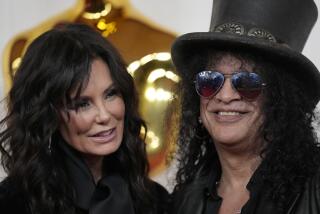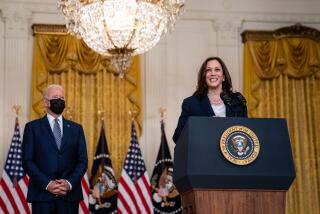At long last, a fitting American Requiem
Christopher Rouse’s Requiem begins beyond emotion. For the first few minutes of the premiere of this extraordinary 90-minute score, Sunday night by the Los Angeles Master Chorale, baritone Sanford Sylvan stood alone on a darkened Walt Disney Concert Hall stage. Unaccompanied, he intoned a cheerless lyric by Irish poet Seamus Heaney.
The song lies somewhere between chant and chantey. Sadness is presented as an offering, prayerful yet oddly matter-of-fact. Each exquisitely enunciated word, delivered by Sylvan in haunting rounded tones, was like a bomb gift-wrapped. A 4-year-old has died.
The chorus, also a cappella, follows with a somber madrigal. Rouse sets “Requiem aeternam” (“Eternal rest”) with slightly sour chromatic harmonies. Sopranos, altos, tenors and finally basses come in. The dynamics are quiet with a couple of modest crescendos, as if the music must sneak around frightful death. But before long, all hell breaks loose. Rouse requires that the orchestra include seven hard-working, uninhibited percussionists. Later -- with the help of a rousing large chorus, children’s chorus and orchestra in full bloom -- all heaven breaks loose.
Rouse’s is the first great traditional American Requiem. Ours is not a heritage rich in settings of the Latin Mass for the dead. For public mourning, European masterworks -- the requiems of Mozart and Faure -- suffice. The overpoweringly theatrical requiems of Verdi and Berlioz are entertainment. When terrorists attacked the World Trade Center, the New York Philharmonic could easily pull out Brahms’ dour “German Requiem.” Roger Sessions’ Requiem-like “When Lilacs Last in the Dooryard Bloom’d” or Philip Glass’ massive interfaith choral Fifth Symphony (“Requiem, Bardo, Nirmanakaya”) should mean more to New Yorkers but are less conventional and far removed from the orchestra’s core repertory.
The inspiration for Rouse’s Requiem was Berlioz. It was commissioned for the 2003 bicentennial of Berlioz’s birth by a Chicago choral association, and Rouse wrote his explosive, apocalyptic score in New York in the wake of 9/11. And a first impression of the new Requiem could be one of dynamic excess.
But that’s the first impression of any big new Rouse score, especially when an orchestra is involved. Rouse is a composer known for sextuple, septuple and octuple fortes. That is, he asks players for six, seven or eight times the normal indication for loud. The result can be a joyous racket, a terrible racket or, as it is in the Requiem, a combination of both.
Excess difficulty has been another impression of Rouse’s score, which proved too demanding for its original commissioner. Grant Gershon, the Master Chorale’s music director, became the first to rise to Rouse’s challenge of raising the rafters. And that he did Sunday, with trumpets pealing to summon the dead or, when God is described in all His majestic glory, with percussion storming the land and the chorus describing the indescribable.
But under it all is a magnificent lyricism, which is the real Berlioz influence. Small, seemingly unimportantly melodic or rhythmic details swell into wildly unpredictable castles of glory.
Interpolated poetry by Siegfried Sassoon, Ben Jonson, John Milton and Michelangelo (in Italian) serves as text for the baritone solos. The soloist is the individual. The chorus, which sings the Mass text, is the masses. Rouse clings closely in his vocal lines to both the sound of words and their sentiment.
In the end, Rouse’s is a Requiem of wondrous mixed emotions. Death’s inexhaustible fury exhausts baritone, chorus and orchestra. The Los Angeles Children’s Chorus, which sat with impressive patience for 70 minutes before limning heaven’s light in sweet tones in the Sanctus, became the voice of fresh hope.
But hope and hopelessness can never coalesce. The final resting point of the traditional Mass is the Agnus Dei. Rouse ends it with the chorus melody evaporating into thin air. Strings and percussion fade away in a shimmer. The baritone quietly sings, for the first time in Latin, “Grant them rest.” Then come the startling, potentially heart-attack-inducing sextuple forte hammer blows of chimes and a bass drum.
A simple folk song then, for the chorus and the children, is balm. Sylvan simultaneously wrestling with Michelangelo’s wishful ode, “On Immortality,” is not. Vernacular caroling verges on Hallmark sentimentality, but complexity creeps in. The baritone sings “Amen” -- five descending unaccompanied notes. The Requiem ends where it begins, outside emotion, without conclusion or answers. We know nothing of death except its existence.
The Master Chorale and its orchestra have been making enormous strides technically under Gershon’s direction. Rouse’s Requiem is their biggest challenge to date. The performance was comprehensive and exalted.
A recording is now a must. Telarc has pulled out of its commitment to make one. Other labels should treat that as a stroke of luck.
*
More to Read
The biggest entertainment stories
Get our big stories about Hollywood, film, television, music, arts, culture and more right in your inbox as soon as they publish.
You may occasionally receive promotional content from the Los Angeles Times.







